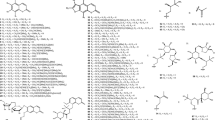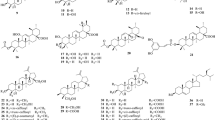Abstract
Extensive scientific research on Echinacea species revealed that the bioactive components most likely responsible for the immunostimulatory activities of Echinacea were alkamides, caffeic acid derivatives, glycoproteins, and polysaccharides. Three species, namely Echinacea purpurea, E. angustifolia and E. pallida, are predominantly used in herbal supplement preparations. Also, different plant parts are shown to have different amounts of the bioactive components. In addition, the phytochemistry, quality control based analysis of bioactive constituents, as well as addressing the safety concerns related to Echinacea herbal supplement preparations are discussed.
Access this chapter
Tax calculation will be finalised at checkout
Purchases are for personal use only
Similar content being viewed by others
References
American Herbal Pharmacopoeia. 2010a. Echinacea angustifolia Root: Standards of analysis, quality control, and therapeutics. Scotts Valley, CA: American Herbal Pharmacopoeia and Therapeutic Compendium.
———. 2010b. Echinacea pallida root: Standards of analysis, quality control, and therapeutics. Scotts Valley, CA: American Herbal Pharmacopoeia and Therapeutic Compendium.
Barnes, J., L.A. Anderson, S. Gibbons, and J.D. Phillipson. 2005. Echinacea species (Echinacea angustifolia (DC.) Hell. Echinacea pallida (Nutt.) Nutt., Echinacea purpurea (L.) Moench): a review of their chemistry, pharmacology and clinical properties. The Journal of Pharmacy and Pharmacology 57(8): 929–954.
Bauer, R., P. Remiger, and H. Wagner. 1988. Alkamides from the roots of Echinacea purpurea. Phytochemistry 21(7): 2339–2342.
Bauer, R., P. Remiger, and H. Wagner. 1988b. Echinacea Part 3. Comparative TLC and HPLC analysis of herbal drugs from Echinacea purpurea, E. pallida and E. angustifolia. Deutsche Apotheker-Zeitung 128(4): 174–180.
Bauer, R., P. Remiger, and H. Wagner. 1989. Alkamides from the roots of Echinacea angustifolia. Phytochemistry 28(2): 505–508.
Bauer, R., and P. Remiger. 1989. Echinacea. Part V. TLC and HPLC analysis of alkamides in Echinacea drugs. Planta Medica 55(4): 367–371.
Bauer, Rudolf, and S. Foster. 1991. Echinacea. Part VI. Analysis of alkamides and caffeic acid derivatives from Echinacea simulata and E. paradoxa roots. Planta Medica 57(5): 447–449.
Bauer, R. 1999. Chemistry, analysis and immunological investigations of Echinacea phytopharmaceuticals. In: Wagner, H. (ed.). Immunomodulatory Agents from Plants. Basel, Switzerland: Birkhuser Verlag. 41–88.
Becker, H., W.C. Hsieh, R. Wylde, C. Laffite, and C. Andary. 1982. Structure of echinacoside. Zeitschrift fuer Naturforschung. C. Journal of Biosciences 37C(5-6): 351–353.
Bergeron, C., and S. Gafner. 2007. Quantitative analysis of the polysaccharide and glycoprotein fractions in Echinacea purpurea. and Echinacea angustifolia by HPLC-ELSD for quality control of raw material. Pharmaceutical Biology 45(2): 98–105.
Bohlmann, F., and M. Grenz. 1966. Polyacetylene compounds. CXII. Components of Echinacea varieties. Chemische Berichte 99(10): 3197–3200.
Bohlmann, F., and H. Hoffmann. 1983. Further amides from Echinacea purpurea. Phytochemistry 22(5): 1173–1175.
Borchers, A.T., C.L. Keen, J.S. Stern, and M.E. Gershwin. 2000. Inflammation and native American medicine: The role of botanicals. The American Journal of Clinical Nutrition 72(2): 339–347.
Brown, P.N., M. Chan, and J.M. Betz. 2010. Optimization and single-laboratory validation study of a high-performance liquid chromatography (HPLC) method for the determination of phenolic Echinacea constituents. Analytical and Bioanalytical Chemistry 397(5): 1883–1892.
Cech, N.B., M.S. Eleazer, L.T. Shoffner, M.R. Crosswhite, A.C. Davis, and A.M. Mortenson. 2006. High performance liquid chromatography/electrospray ionization mass spectrometry for simultaneous analysis of alkamides and caffeic acid derivatives from Echinacea purpurea extracts. Journal of Chromatography. A 1103(2): 219–228.
Cheminat, A., R. Zawatzky, H. Becker, and R. Brouillard. 1988. Caffeoyl conjugates from Echinacea species: Structures and biological activity. Phytochemistry 27(9): 2787–2794.
Chen, Y., T. Fu, T. Tao, J. Yang, Y. Chang, M. Wang, L. Kim, L. Qu, J. Cassady, R. Scalzo, and X. Wang. 2005. Macrophage activating effects of new alkamides from the roots of Echinacea species. Journal of Natural Products 68: 773–776.
Cozzolino, R., P. Malvagna, E. Spina, A. Giori, N. Fuzzati, A. Anelli, D. Garozzo, and G. Impallomeni. 2006. Structural analysis of the polysaccharides from Echinacea angustifolia radix. Carbohydrate Polymers 65(3): 263–272.
Dietz, B., and R. Bauer. 2001. The constituents of Echinacea atrorubens roots and aerial parts. Pharmaceutical Biology 39(1): 11–15.
Freeman, C., and K. Spelman. 2008. A critical evaluation of drug interactions with Echinacea spp. Molecular Nutrition & Food Research 52: 789–798.
Glavač, N.K., I.J. Košir, J. Rode, and S. Samo Kreft. 2012. Optimization and use of a spectrophotometric method for determining polysaccharides in Echinacea purpurea. Central European Journal of Biology 7(1): 126–131.
Gocan, S., L. Radu, and M. Hadaruga. 2003. Simultaneous analysis by high performance liquid chromatography of hydrophilic compounds and lipophilic compounds (alkamides) from pharmaceutical preparations of Echinacea purpurea root. Chromatographia 57(9–10): 677–679.
Gupta, M., D. Sharma, A. Sharma, V. Kumari, and O.P. Goshain. 2012. A review on purple cone flower (Echinacea purpurea L. Moench). Journal of Pharmacy Research 5(8): 4076–4081.
Harbonrne, J.B., and C.A. Williams. 2004. Phytochemistry of the Genus Echinacea. In Echinacea. The genus Echinacea, ed. S.C. Miller and H. Yu, 48–64. Boca Raton: CRC.
Hudson, J.B. 2012. Applications of the phytomedicine Echinacea purpurea (purple coneflower) in infectious diseases. Journal of Biomedicine & Biotechnology 2012: 769896.
Huntley, A.L., J.T. Coon, and E. Ernst. 2005. The safety of herbal medicinal products derived from Echinacea species: a systematic review. Drug Safety 28(5): 387–400.
Jacobson, M. 1954. Occurrence of a pungent insecticidal principle in American coneflower roots. Science 120: 1028–1029.
Jacobson, M. 1967. The Structure of echinacein, the insecticidal component of American coneflower Roots. The Journal of Organic Chemistry 32: 1646–1647.
Kindscher, K. 1989. The ethnobotany of the purple coneflower (Echinacea angustifolia) and other Echinacea species. Economic Botany 43(4): 498–507.
Kraemer, H., and M. Sollenberger. 1911. The pharmacognosy of Echinacea. The American Journal of Pharmacy 83: 315–324.
Kotowska, D., R.B. El-Houri, K. Borkowski, R.K. Petersen, X.C. Fretté, G. Wolber, K. Grevsen, K.B. Christensen, L.P. Christensen, and K. Kristiansen. 2014. Isomeric C12-alkamides from the roots of Echinacea purpurea improve basal and insulin-dependent glucose uptake in 3T3-L1 adipocytes. Planta Medica 80(18): 1712–1720.
LaLone, C.A., K.D.P. Hammer, L. Wu, J. Bae, N. Leyva, Y. Liu, A.K.S. Solco, G.A. Kraus, P.A. Murphy, E.S. Wurtele, O.K. Kim, K. Seo II, M.P. Widrlechner, and D.F. Birt. 2007. Echinacea species and alkamides inhibit prostaglandin E2 production in RAW264.7 mouse macrophage cells. Journal of Agricultural and Food Chemistry 55(18): 7314–7322.
Luo, X.B., B. Chen, S.Z. Yao, and J.G. Zeng. 2003. Simultaneous analysis of caffeic acid derivatives and alkamides in roots and extracts of Echinacea purpurea by high-performance liquid chromatography-photodiode array detection-electrospray mass spectrometry. Journal of Chromatography. A 986(1): 73–81.
Miller, S.C. 2004. Echinacea in vivo: a prophylactic agent in normal mice and a therapeutic agent in leukemic mice. In Echinacea. The genus Echinacea, ed. S.C. Miller and H. Yu, 150–158. Boca Raton: CRC Press.
Mills, S., and K. Bone. 2005. The essential guide to herbal safety. St. Louis, Missouri: Elsevier Health Sciences.
Mitscher, L.A., and R. Cooper. 2004. Echinacea and immunostimulation. In Herbal and traditional medicine biomolecular and clinical aspects, ed. Packe Lester, Ong Choon Nam, and Halliwell Barry, 721–756. Boca Raton: CRC Press.
Mudge, E., D. Lopes-Lutz, P. Brown, and A. Schieber. 2011. Analysis of alkylamides in Echinacea plant materials and dietary supplements by ultrafast liquid chromatography with diode array and mass spectrometric detection. Journal of Agricultural and Food Chemistry 59(15): 8086–8094.
Pellati, F., G. Orlandini, and S. Benvenuti. 2012. Simultaneous metabolite fingerprinting of hydrophilic and lipophilic compounds in Echinacea pallida by high-performance liquid chromatography with diode array and electrospray ionization-mass spectrometry detection. Journal of Chromatography. A 1242: 43–58.
Pillai, S., C. Pillai, L.A. Mitscher, and R. Cooper. 2007. Use of quantitative flow cytometry to measure ex vivo immunostimulant activity of echinacea: the case for polysaccharides. Journal of Alternative Comparative Medicine 2007(13): 625–634.
Proksch, A., and H. Wagner. 1987. Structural analysis of a 4-O-methylglucuronoarabinocylan with immunostimulating activity from Echinacea purpurea. Phytochemistry 26: 1989–1993.
Rininger, J.A., K. Ringer, and M. Savarese. 2004. In vitro immunopharmacology of Echinacea. In Echinacea. The genus Echinacea, ed. S.C. Miller and H. Yu, 165–176. Boca Raton: CRC.
Sestakova, H., and B. Turek. 2004. Effect of Echinacea on cells involved in disease defense. In Echinacea. The genus Echinacea, ed. S.C. Miller and H. Yu. Boca Raton: CRC Press.
Shin, D.M., K.M. Choi, Y.S. Lee, W. Kim, K.O. Shin, S. Oh, J.C. Jung, M.K. Lee, Y.M. Lee, J.T. Hong, Y.P. Yun, and H.S. Yoo. 2014. Echinacea purpurea root extract enhances the adipocyte differentiation of 3T3-L1 cells. Archives of Pharmacal Research 37(6): 803–812.
Stimpel, M., A. Proksch, H. Wagner, and M.L. Lohmann-Matthes. 1984. Macrophage activation and induction of macrophage cytotoxicity by purified polysaccharide fractions from the plant Echinacea purpurea. Infection and Immunity 46(3): 845–849.
Stoll, A., J. Renz, and A. Brack. 1950. Isolation and constitution of the Echinacoside, a glycoside from the roots of Echinacea angustifolia DC 6. Notification of antibacterial substances. Helvetica Chimica Acta 33(6): 1877–1893.
Stuppner, H. 1985. Chemische und immunologische Untersuchungen von Polysacchariden aus der Gewebekultur von Echinacea purpurea (L.) Moench, Ph.D. thesis, University of Münich.
Wagner, H., and A.Z. Proksch. 1981. Über ein immunstimulerendes workprinzip aus Echinacea purpurea Moench (An immunostimulating active principle from Echinacea purpurea Moench). Zeitschrift für Angewandte Phytotheraphy 2: 166–171.
Wagner, H., A. Proksch, I. Riess-Maurer, A. Vollmar, S. Odenthal, H. Stuppner, K. Jurcic, M. Le Turdu, and Y.H. Heur. 1984. Immunostimulating polysaccharides (heteroglycans) from higher plants. Arzneimittel Forschung 34(6): 659–661.
Wagner, H., H. Stuppner, W. Schäfer, and M. Zenk. 1988. Immunologically active polysaccharides of Echinacea purpurea cell cultures. Phytochemistry 27: 119–126.
Author information
Authors and Affiliations
Corresponding author
Editor information
Editors and Affiliations
Rights and permissions
Copyright information
© 2016 Springer International Publishing Switzerland
About this chapter
Cite this chapter
Cao, C., Kindscher, K. (2016). The Medicinal Chemistry of Echinacea Species. In: Kindscher, K. (eds) Echinacea. Springer, Cham. https://doi.org/10.1007/978-3-319-18156-1_9
Download citation
DOI: https://doi.org/10.1007/978-3-319-18156-1_9
Published:
Publisher Name: Springer, Cham
Print ISBN: 978-3-319-18155-4
Online ISBN: 978-3-319-18156-1
eBook Packages: Biomedical and Life SciencesBiomedical and Life Sciences (R0)




